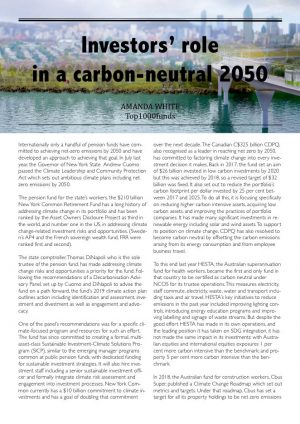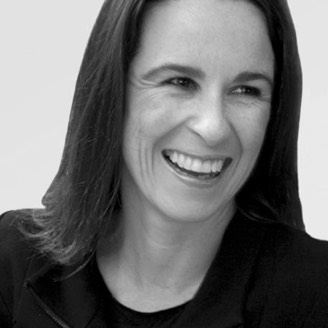 Internationally only a handful of pension funds have committed to achieving net-zero emissions by 2050 and have developed an approach to achieving that goal. In July last year, the Governor of New York State Andrew Cuomo passed the Climate Leadership and Community Protection Act which sets out ambitious climate plans including net zero emissions by 2050.
Internationally only a handful of pension funds have committed to achieving net-zero emissions by 2050 and have developed an approach to achieving that goal. In July last year, the Governor of New York State Andrew Cuomo passed the Climate Leadership and Community Protection Act which sets out ambitious climate plans including net zero emissions by 2050.
The pension fund for the state’s workers, the $210 billion New York Common Retirement Fund has a long history of addressing climate change in its portfolio and has been ranked by the Asset Owners Discloure Project as third in the world, and number one in the US, in addressing climate change-related investment risks and opportunities. (Sweden’s AP4 and the French sovereign wealth fund, FRR were ranked first and second).
The state comptroller, Thomas DiNapoli who is the sole trustee of the pension fund, has made addressing climate change risks and opportunities a priority for the fund. Following the recommendations of a Decarbonisation Advisory Panel, set up by Cuomo and DiNapoli to advise the fund on a path forward, the fund’s 2019 climate action plan outlines action including identification and assessment, investment and divestment as well as engagement and advocacy.
One of the panel’s recommendations was for a specific climate-focused program and resources for such an effort. The fund has since committed to creating a formal, multi-asset-class Sustainable Investment-Climate Solutions Program (SICP), similar to the emerging manager programs common at public pension funds, with dedicated funding for sustainable investment strategies. It will also hire investment staff including a senior sustainable investment officer and formally integrate climate risk assessment and engagement into investment processes. New York Common currently has a $10 billion commitment to climate investments and has a goal of doubling that commitment over the next decade. The Canadian C$325 billion CDPQ, also recognised as a leader in reaching net zero by 2050, has committed to factoring climate change into every investment decision it makes. Back in 2017, the fund set an aim of $26 billion invested in low carbon investments by 2020 but this was achieved by 2018, so a revised target of $32 billion was fixed. It also set out to reduce the portfolio’s carbon footprint per dollar invested by 25 per cent between 2017 and 2025. To do all this, it is focusing specifically on reducing higher carbon intensive assets, acquiring low carbon assets, and improving the practices of portfolio companies. It has made many significant investments in renewable energy including solar and wind assets. To support its position on climate change, CDPQ has also resolved to become carbon neutral by offsetting the carbon emissions arising from its energy consumption and from employee business travel.
To this end last year HESTA, the Australian superannuation fund for health workers, became the first and only fund in that country to be certified as carbon neutral under NCOS for its trustee operations. This measures electricity, staff commute, electricity, waste, water and transport including taxis and air travel. HESTA’s key initiatives to reduce emissions in the past year included improving lighting controls, introducing energy education programs and improving labelling and signage of waste streams. But despite the good effort HESTA has made in its own operations, and the leading position it has taken on SDG integration, it has not made the same impact in its investments: with Australian equities and international equities exposures 1 per cent more carbon intensive than the benchmark; and property 5 per cent more carbon intensive than the benchmark.
In 2018, the Australian fund for construction workers, Cbus Super, published a Climate Change Roadmap which set out metrics and targets. Under that roadmap, Cbus has set a target for all its property holdings to be net zero emissions by 2030. It currently holds around A$5 billion in property but because of its growth those assets could be as high as A$10 billion by the time the deadline comes around.
Property fund managers have been given until this year to outline their roadmaps for net zero emissions holdings targeting 2030. Australian and New Zealand investors are enthusiastic about climate aligned investment strategies but few have set specific targets, a report commissioned by the IGCC has shown. [The chair of Cbus’ investment committee, Stephen Dunne, is also chair of the IGCC.]
The report, which looks at Australian and New Zealand investors with funds representing more than A$1.3 trillion in assets, shows that only 35 per cent have set specific targets for their whole portfolio and just over 40 per cent of real estate investors and less than 25 per cent of listed equities investors have set targets. From a total portfolio or multi-asset view, the A$24 billion VicSuper has embarked on a pathway towards a net zero emissions portfolio but has not formally set a deadline. VicSuper was one of the first Australian super funds to measure the carbon intensity of its equities portfolio and as at June 2019, VicSuper’s equities investments had a weighted average carbon intensity of 240 tonnes of CO2e/A$M against a benchmark of 245 tonnes.
The fund has an international equity customised carbon strategy and has reached its target of A$3 billion in sustainable outcomes. The fund reports carbon intensity on equities, fixed interest and real assets in recognition of a net zero emissions target by 2050. Some of the investments the fund has made in the past year include a reduced carbon intensity of small cap strategies working with existing small cap Australian managers to achieve a 25 per cent reduction in carbon intensity. It also invested in a waste to energy company, ESG Australian and global bond index funds, and a real estate office fund. In July this year the merger between VicSuper and First State Super, to create one of the country’s largest superannuation funds with A$125 billion in assets will be finalised.
Meanwhile the largest pension fund in the US, the $402 billion Californian fund CalPERS has recently made a commitment to achieve net-zero by 2050 by becoming the first US investor to join the Net Zero Asset Owner Alliance. CalPERS, which was a founder and convenor of Climate Action 100+, has been a leading voice advocating that climate change is a systemic risk for investors and is active through mediums such as the SEC’s Investor Advisory Committee and the International Financial Reporting Standards Advisory Committee. It also annually joins the Global Investor Statement on Climate Change. CalPERS’s goal is to have 100 per cent of its investment policy and procedures integrate sustainability factors, including climate change, across the total fund portfolio by 2021 as part of the strategic plan on sustainable investment.
Last year, it also announced it would pilot research by Wellington Management and Woods Hole Research Center to research potential links between climate models and financial risks and how to develop investment insights. CalPERS has also estimated carbon foot printing for three out of four asset classes – global equity, global fixed income, and real assets – representing 90 percent of the fund’s investments by value.
The UK government is looking at whether to require pensions to disclose their climate change strategies under the Taskforce on Climate-Related Financial Disclosures, but many of the UK’s largest funds are not waiting for the directive. The £30 billion Brunel Pension Partnership set out a comprehensive new climate policy in January that goes way beyond its own actions and includes a five-point plan for building a financial system that is fit for a zero-carbon future. This includes working with policy makers, encouraging more investable climate-related products and a promise to ensure all its external managers integrate climate change. As an example of how seriously the fund is taking this, it just carbon footprinted all 20 managers shortlisted in a global high alpha mandate, from which five won mandates.
Under the Paris agreement, the EU has committed to carbon neutrality by the second half of the 21st century and it’s Europe that leads the world in terms of institutional investor action to reduce climate related risk. The Dutch funds, APG and PGGM, as well as the French, Swedish and Danish funds are leaders in sustainability. The Danish pension sector has committed to invest €47 billion in the green transition by 2030, supporting the government’s climate ambitions of reducing greenhouse gas emissions by 70 per cent. It represents about one sixth of the total private pension assets in that country.
Looking at the activities of Sweden’s AP4 shows how far behind other large institutional investors currently are. AP4 has been investing in low-carbon strategies since 2012 and was the founding pension fund member of the Portfolio Decarbonisation Coalition which has now mobilised $800 billion for low carbon investments. AP4’s target is to have 100 per cent of its global equities portfolio invested in low carbon strategies.
In 2014 it set a target of 10 per cent and by 2017 just over 30 per cent of the global equity portfolio was in low carbon strategies. And as far back as 2014, the carbon footprint of AP4’s listed equities portfolio was 28 per cent lower than the benchmark index. When AP4 initiated its low carbon equity initiatives, there was a lack of suitable investment products for large institutions but that didn’t stop its progress. Instead it worked with providers to become instrumental in designing indexes, and an early investor in strategies, in order to help build the market. At the beginning of 2019 new investment guidelines for the Swedish AP funds stated that special emphasis must be given to how sustainable development can be promoted. Most recently the largest pension fund in Europe, the €450 billion Dutch ABP, which has long been a leader in sustainability, set out its sustainability and responsible investment plan for 2025 this January. The plan sets out long term objectives – in line with the goal of a climate-neutral economy by 2050 – as well as the short term steps to achieve that.
The fund achieved its 2020 goals, set in the strategic plan of 2015, which saw it reduce its carbon footprint by 30 per cent since 2015 and commit €10 billion to renewables. The new plan increases those goals to 40 per cent and €15 billion respectively in what is a continuous target. But the 2025 strategic plan does more than set targets, it takes the sustainability leader into the next decade and beyond, expanding the scope beyond climate to include resource scarcity and digitalisation.
ABP says to achieve a climate-neutral global economy by 2050, the transition to a circular economy is essential and it wants to accelerate this transition so that by 2030 efficient and socially responsible raw material supply chains are common practice in companies. It has said it will invest more in companies with circular business models and innovative solutions for food and natural resource scarcity.
It has also connected sustainability and digitilisation, saying that by 2050 digitalisation should lead to responsible value creation and provide solutions to challenges such as climate change and the scarcity of natural resources. One of ABP’s goals is to have more invested in companies that can demonstrate a contribution to this by 2025 and it will also set criteria to assess whether companies respect the digital rights of employees, consumers, and users.
It’s a bold step for a fund already at the forefront, and another indicator of what sustainability leadership looks like.
Amanda White
Originally published
by Top1000funds.com
February 13, 2020

